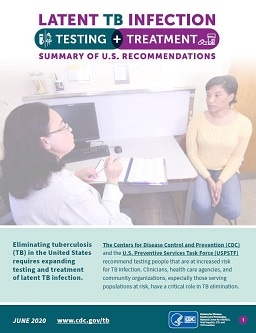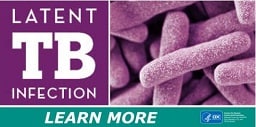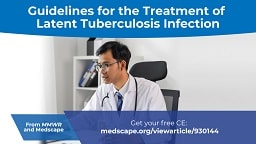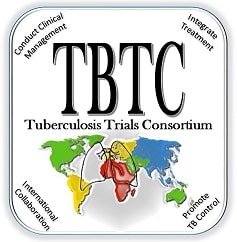TB NOTES

TB Notes 2, 2020
Notes from the Director

Dear Colleague,
I would like to acknowledge and thank our TB colleagues from across the country and around the world who continue to contribute to the COVID-19 pandemic response. Those on the frontlines have responded heroically and creatively, coming up with new ways to provide essential health care services. For example, in this issue, we highlight how the New York City Bureau of Tuberculosis Control leveraged a pilot program to rapidly expand telehealth for patients with active TB disease and latent TB infection to reduce unnecessary clinic visits while maintaining continuity of TB care.
During this time, we have seen shifts in staff roles and responsibilities, and resources in public health departments and healthcare facilities to address the growing needs of the COVID-19 response. Likewise, many Division of Tuberculosis Elimination (DTBE) staff have responded to the call to assist in CDC’s response to COVID-19. As of June 12th, 72 DTBE staff members have participated in 100 deployments supporting CDC’s COVID-19 response efforts. These 72 staff members represent 45% of DTBE staff, joining over 380 staff from the National Center for HIV/AIDS, Viral Hepatitis, STD, and TB Prevention who have been deployed to work on COVID-19 response activities. DTBE staff members have participated in multiple deployments, and some are even on their third or fourth rotation. These deployments have been to both the CDC Emergency Operations Center (EOC) in Atlanta, and to aid state and local agencies in the field throughout the United States. Activities for EOC deployments have included data management and analysis, programmatic outreach, operations coordination, communications and training, and the development of medical countermeasures. Staff members deploying to the field have served as screeners at CDC quarantine stations and military installations and have assisted local programs with contact tracing. DTBE has shared its expertise on contact tracing and interviewing by providing training courses, guides, and patient education materials created by DTBE and the DTBE-sponsored TB Centers of Excellence. DTBE’s embedded field-based staff have also participated in the response efforts of their assigned local jurisdictions. Thank you to everyone who has responded to the COVID-19 pandemic!
In April 2020, CDC published an updated summary of recommendations for latent TB infection testing and treatment in the United States.pdf icon The updates describe who should be tested, the types of recommended tests for TB infection and the recommended treatment regimens for latent TB infection. Medscape published a “5 Things to Know” article titled, “Latent TB Infection: New Guidelines and Preferred Treatmentsexternal icon,” that describes five key points from the new latent TB infection treatment guidelines. Also, MMWR and Medscape partnered to release free continuing education (CE) credit for the updated latent TB infection treatment guidelinesexternal icon.
In June, Sanofi alerted DTBE, other health agencies, and stakeholders worldwide about a newly detected impurity in Priftin®. Rifapentine (supplied as Priftin® manufactured by Sanofi) is part of a 3-month regimen with isoniazid (3HP) for treating latent TB infection and preventing TB disease. As a precautionary measure, Sanofi paused the release of Priftin® from its production sites. At this time, neither the U.S. Food and Drug Administration (FDA) nor Sanofi has requested a recall of the Priftin® supply. FDA has not issued any new advisory about Priftin®. Read CDC’s Dear Colleague Letter to learn more about what this means for the prevention of TB disease and treatment of latent TB infection, particularly the 3HP treatment regimen for latent TB infection.
Finally, because of the COVID-19 pandemic, many planned meetings, trainings, and conferences have been changed to virtual meetings, postponed, or cancelled altogether. The Advisory Council for the Elimination of Tuberculosis (ACET)’s met virtually on June 16, 2020. On May 7–8, 2020, the Tuberculosis Trials Consortium (TBTC) held a successful abridged virtual meeting with participants from all over the world. For the latest information on the status of other activities, please visit DTBE’s calendar on our website.
Thank you for your continued work on the COVID-19 response, and your dedication to continue to prevent and control TB.
Philip LoBue, MD, FACP, FCCP
Director
Division of Tuberculosis Elimination
National Center for HIV/AIDS, Viral Hepatitis, STD, and TB Prevention
TB Drug Shortage Management and Reporting
U.S. TB programs are frequently confronted with intermittent stockouts of drugs used in the treatment of latent TB infection and both drug-susceptible and drug-resistant TB disease. When TB program personnel cannot access a particular drug for their patients, they contact the National Tuberculosis Controllers Association (NTCA) and their project officer in DTBE, who summarize information about the stockout and share it with DTBE’s Office of Policy and Issues Management. During March and April 2020, TB programs had difficulty obtaining rifabutin, ethambutol, rifapentine, pyrazinamide, and moxifloxacin.
DTBE works closely with the Food and Drug Administration’s Center for Drug Evaluation and Research, which monitors drug shortages in the United States. In some situations, especially if the stockouts are temporary or only affect some regions or distributors, FDA recommends that TB programs contact manufacturers to directly purchase drugs to ensure patients’ therapy is not interrupted.
DTBE encourages TB programs to report difficulty in obtaining TB drugs or diagnostics to NTCA’s websiteexternal icon and their DTBE Project Officers. FDA posts updates on national drug shortages and estimated dates of resolution on the FDA Drug Shortages websiteexternal icon. TB programs seeking treatment consultations related to drug shortages should contact their local or state TB medical consultant or corresponding regional TB Center of Excellence for Training, Education, and Medical Consultation (COE).
Submitted by Ann Cronin, BA, Associate Director for Policy and Issues Management
New Medication Trackers for Short-Course Latent TB Infection Treatment Regimens
For patients receiving treatment for latent TB infection, following a treatment regimen may be complicated. Understanding how much medication to take and how often to take the medication is necessary for treatment adherence. CDC created two new medicine trackers for the latent TB infection treatment regimens to help patients record their medication intake: three months of daily isoniazid plus rifampin (3HR) and four months of daily rifampin (4R). These two new trackers are in addition to the medication tracker for three months of once-weekly isoniazid plus rifapentine (3HP). Clinicians are encouraged to provide patients with these trackers to help the patients track their medication for the treatment of latent TB infection.
Access the trackers for the three preferred short-course regimens (3HP, 4R, and 3HR) to help patients track their medication for treating latent TB infection here.

Updated Summary Document on U.S. Latent TB Infection Testing and Treatment Recommendations
In April 2020, CDC published an updated summary of recommendations for latent TB infection testing and treatment in the United States. The updates describe who should be tested, the types of recommended tests for TB infection and the recommended treatment regimens for latent TB infection. One update to the recommendations is the NTCAexternal icon and CDC preferentially recommend short-course, rifamycin-based, 3- or 4-month latent TB infection treatment regimens over 6- or 9-month isoniazid monotherapy (i.e., 6H or 9H, respectively). Research shows that shorter treatments increase completion rates and reduce patient side effects.
Learn more in the new Latent TB Infection Testing and Treatment: Summary of U.S. Recommendationspdf icon.
Medscape’s “5 Things to Know” about the Updates to the U.S. Latent TB Infection Recommendations

On April 27, 2020 Medscape published a “5 Things to Know” article titled, “Latent TB Infection: New Guidelines and Preferred Treatments.” The article describes five key points from the new latent TB infection treatment guidelines to treat latent TB infection.
Read the Medscape article: Latent TB Infection: New Guidelines and Preferred Treatmentsexternal icon.

Free Continuing Education Credit Available from MMWR and Medscape
On May 21, 2020, MMWR and Medscape partnered to release a continuing education (CE) activity for healthcare providers to earn free CE credit. The activity is based on the updated 2020 latent TB infection treatment guidelines that include the NTCA- and CDC-recommended treatment regimens that comprise three preferred rifamycin-based regimens and two alternative monotherapy regimens with daily isoniazid.
The CE activity is valid for credit through May 21, 2021. Access the activity on Medscape’s webpage: Guidelines for the Treatment of Latent Tuberculosis Infection: Recommendations From the National Tuberculosis Controllers Association and CDC, 2020external icon.
If you are not a registered user on Medscape, please register for free or login without a passwordexternal icon and get unlimited access to all continuing education activities and other Medscape features.
DTBE & TB Centers of Excellence (COEs) Contact Investigation Resources
Contact tracing is increasingly becoming an important strategy in the COVID-19 response. Contract tracing approaches from other disease areas, such as TB, have been adapted for the COVID-19 response. DTBE and the TB Centers of Excellence have many contact investigation resources available, including training courses, guides, and patient education materials.
DTBE Materials
- Effective TB Interviewing for Contact Investigation
- TB Contact Investigation Interviewing Skills Course
- Module 8: Contact Investigations for Tuberculosispdf icon
- Protect Your Family and Friends From TB: The TB Contact Investigationpdf icon— Patient Education Brochure
- Guidelines for the Investigation of Contacts of Persons with Infectious Tuberculosis: Recommendations from the National Tuberculosis Controllers Association and CDC MMWR 2005; 54 (No. RR-15, 1-37)
- Investigation of Contacts of Persons with Infectious Tuberculosis, 2005— Slide Set
- Resources for TB Programs includes a section on TB Contact Investigations
Centers of Excellence Materials
- Global Tuberculosis Institute at Rutgers, The State University of New Jersey
- Effective Interviewing for Tuberculosis Contact Investigationexternal icon— Video
- Tuberculosis Education and the Congregate Setting Contact Investigation: A Resource for the Public Health Workerexternal icon
- Tuberculosis Contact Investigation in Congregate Settings: A Resource for Evaluationexternal icon
- TB Interviewing for Contact Investigation: A Practical Resource for the Healthcare Workerexternal icon
- Performance Guidelines for Contact Investigation: The TB Interviewexternal icon
- TB Simulated Patients: A Training Resource for the Contact Investigation Interviewexternal icon
- Southeastern National Tuberculosis Center
Submitted by Nick DeLuca, PhD, MA, BA, Branch Chief and Allison Maiuri, MPH Team Lead for Education, Training and Behavioral Studies Team
Adam J. Langer, DVM, MPH, DACVPM Selected as Branch Chief
DTBE is pleased to announce the selection of Adam J. Langer, DVM, MPH, DACVPM as the Chief of the Surveillance, Epidemiology and Outbreak Investigations Branch (SEOIB), following the retirement of Dr. Thomas Navin. Dr. Langer officially assumed this role on March 1, 2020.
Dr. Langer has been the Surveillance Team Lead in SEOIB since 2015. In that role, he oversaw all data management, analysis, and interpretation activities for U.S. TB surveillance. Under his leadership, DTBE and its state and local partners collaborated to develop the 2020 Report of Verified Case of Tuberculosis and designed the TB Latent Infection Surveillance System, both of which will be implemented starting this year. Before leading the SEOIB Surveillance Team, Dr. Langer served as a Senior Quarantine Veterinary Medical Officer and lead of the Importations and Animal Contact Team in CDC’s Division of Global Migration and Quarantine (2012–2015) and before that as an epidemiologist on SEOIB’s Outbreak Investigations Team and Molecular Epidemiology Activity (2009–2012). During this earlier service in SEOIB, in addition to leading several cluster and outbreak investigations, Dr. Langer helped ensure the on-time launch of TB GIMS in 2010, founded the Outbreak Detection Working Group, reestablished the division’s TB in correctional settings workgroup, and contributed to updating the division’s outbreak response plan. Before joining CDC as a permanent staff member, he served as an Epidemic Intelligence Service Officer assigned to the New Jersey Department of Health (2006–2008) and as a Preventive Medicine Fellow assigned to CDC’s Enteric Diseases Epidemiology Branch (2008–2009). Before beginning his public health training, Dr. Langer practiced companion animal family and emergency veterinary medicine in his hometown of Baltimore.
Dr. Langer earned a bachelor’s degree in biology from Virginia Tech, a doctorate in veterinary medicine from Oklahoma State University, and a master’s degree in public health from Johns Hopkins University; he is also board-certified in veterinary preventive medicine. Dr. Langer has received several prestigious awards for his service to public health including the James H. Steele Veterinary Public Health Award, the CDC National Center for HIV/AIDS, Viral Hepatitis, STD, and TB Prevention Diane Caves Early Career Honor Award, and a CDC National Center for Emerging and Zoonotic Infectious Diseases Nakano citation for outstanding scientific manuscript. He has authored or coauthored nearly 30 scientific journal articles, conference papers, and book chapters related to TB and other topics of public health concern.
Submitted by Brian Sizemore, BS, MBA, Deputy Branch Chief (on behalf of SEOIB)
Rapid Expansion of Telehealth to Maintain TB Care Services During COVID-19 in New York City
The New York City (NYC) Bureau of Tuberculosis Control (BTBC) provides direct care in four TB clinics for patients with TB disease and latent TB infection. Each clinic offers comprehensive services including interferon-gamma release assay testing for TB infection, chest radiography, HIV testing, sputum testing, and medication dispensing. However, three of the four TB clinics are temporarily closed because of the COVID-19 pandemic. Here we describe how we have leveraged our pilot program to rapidly expand telehealth at the remaining clinic to reduce unnecessary clinic visits while maintaining continuity of TB care.
The BTBC Telehealth Pilot Program was implemented at Corona Chest Center in Queens in November 2019. Eligible patients were those who were diagnosed with latent TB infection, were started on appropriate treatment, were clinically stable, could proficiently use their own video-enabled device, and provided verbal consent. Telehealth visits were scheduled as 20-minute videoconferences with nurses using Health Department-approved video software. Nurses assessed signs of adverse events and asked about side effects. If there were none, the nurses scheduled the next video call, issued another month of medication, and mailed it to the patients.
On March 23, 2020, the Corona Chest Center and two other TB clinics closed in response to the “New York State on PAUSE” Executive Order, which, among other requirements, encouraged New Yorkers to stay home and mandated social distancing in public places. Fort Greene Chest Center in Brooklyn has remained open in order to continue providing essential TB care. We have reserved in-person clinic visits for our highest-priority patients. Simultaneously, we have adapted our Telehealth Pilot Program protocol to also include patients with TB disease and rapidly implemented telehealth at Fort Greene Chest Center in order to reduce clinic volume.
Patients have an initial in-person clinic visit, and if there are no laboratory abnormalities, are given a 2-month supply of medication with an appointment for a telehealth visit with a provider in 4–8 weeks. Similar to the Telehealth Pilot Program, telehealth visits are conducted via phone or videoconference using software that meets Health Department privacy standards. If no abnormalities are identified during the telehealth visit, the doctor orders additional medication that is mailed to the patient. Patients with more complex or urgent needs as well as those who lack access to our facility, or the necessary technology are offered home visits or in-person visits as needed. We have written about the other ways we transformed our clinical and community services in the International Journal of Tuberculosis and Lung Diseaseexternal icon.
BTBC’s rapid expansion of telehealth has faced issues related to technical difficulties, data management, and documentation. However, we are satisfied that patients have successfully completed appointments from the safety of their homes. While the process is still being streamlined, we hope that this account of our experience encourages other programs to pursue innovative models of care delivery. During these challenging times, it is critical to continue to adapt to meet patients’ needs and safely provide essential TB services.
Submitted by
Deandra J. Ingram, MPH, CDC Public Health Advisor and Telehealth Coordinator
Michelle Macaraig, DrPH, NYC DOHMH BTBC Director of Policy, Planning & Administration
Joseph Burzynski, MD, NYC DOHMH BTBC Assistant Commissioner and Director
Diana Nilsen, MD, RN, NYC DOHMH BTBC Director of Medical Affairs
Errol Robinson, MPA, NYC DOHMH BTBC Director of Clinic Operations
Claudia Buchanan, MPH, MSN, RN, NYC DOHMH BTBC Patient Care Manager
Christine Chuck, MPA, NYC DOHMH BTBC Director of Disease Investigation and Case Management
Acknowledgments
NYC DOHMH BTBC Physicians and Nurses performing telehealth
Erica Humphrey, NYC DOHMH BTBC City Research Scientist
Using the National Tuberculosis Indicators Project (NTIP) to Select a Focus Area for Program Evaluation
The DTBE Program Evaluation Team is pleased to share “Using the National Tuberculosis Indicators Project to Select a Focus Area for Program Evaluation.” The purpose of this tool is to assist state and local public health programs in selecting specific focus areas within their TB prevention and control program for evaluation and program improvement. The tool offers steps and tips for interpreting information from NTIP indicator reports, NTIP linelist, and the State and City TB Report. If you have any questions or would like additional information about any of the steps in the tool, contact your DTBE program evaluation consultant.
Submitted by Rachel S. Yelk Woodruff, MPH, Health Scientist

Update from the Health Economics Group
Data Management, Statistics, and Evaluation Branch health economists are focused on showing the economic value of TB interventions, examining ways to reduce TB costs to health departments, and aiding programs in estimating current and future costs of TB. They carry out these activities through collaborating with many partners. At present, DTBE health economists are working on the following TB research and evaluation topics:
- Cost and cost-effectiveness of expanded latent TB infection testing and treatment among high-risk populations
- Benefits of using telemedicine a.k.a. eDOT (electronic DOT) to small and large health departments
- Contact tracing costs borne by health departments
- State level costs of TB hospitalizations for Medicaid and Medicare programs
In addition, DTBE health economists are working on several tools to help partners in state and local programs. Two tools in production are the eDOT cost calculator and “Tabby2.”
The eDOT cost calculator is designed to help state and local partners estimate the costs of starting an eDOT program. The calculator will estimate the start-up (e.g., training), fixed costs (e.g., software, phones, webcams, headsets), and staffing requirements for an eDOT program.
Another tool, “Tabby2” (developed by the Harvard T.H. Chan School of Public Health, Prevention Policy Modeling Lab through the NCHHSTP funded Epidemiologic and Economic Modeling Agreement [NEEMA]), is designed to project the impact of expanded latent TB infection testing and treatment on future TB cases in 11 states (California, Florida, Georgia, Illinois, Massachusetts, New Jersey, New York, Pennsylvania, Texas, Virginia, Washington). Eventually, the tool will have modeled results for all 50 states.
Additional forthcoming economics-related products from NEEMA partners include journal articles on the cost-effectiveness of TB interventions in California, Florida, New York, and Texas as well as on the potential impact of effective global TB control on outcomes within the United States.
Submitted by Garrett Beeler Asay, PhD, Economist; Suzanne Marks, BA, MA, MPH, Epidemiologist; and Nicolas Menzies*, PhD, MPH
*Harvard T.H. Chan School of Public Health

Tuberculosis Trial Consortium 45th Semi-Annual Meeting
For the first time in the history of the Tuberculosis Trials Consortium (TBTC)external icon, DTBE’s Clinical Research Branch (CRB) held the TBTC 45th Semi-Annual Meeting on May 7-8 as a virtual meeting. The meeting was held on the Zoom platform and was a great success with approximately 150 participants worldwide. The agenda included updates on TBTC activities since the October 2019 meeting; a Director’s update on DTBE from Dr. LoBue; updates on studies 31, 35, and 37; a murine study update; updates from the Community Research Advisors Group and Treatment Action Group; presentations from the Gates Medical Research Institute and South Africa’s Aurum Institute; and a presentation on use of study 31 data in researching biomarkers for response to TB treatment. CRB is grateful to all who presented in this virtual forum and pleased that we were able to successfully uphold the semi-annual meeting in the COVID-19 environment.
Submitted by Carla Jeffries, JD, MPH, Deputy Branch Chief

Truman and Mary Sue Thornton on their wedding day March 31, 1953
Finding Love at “The San” − Reflections from the Arkansas TB Controller
In the early 1950’s Truman Thornton and Mary Sue Prince found themselves admitted to the Arkansas Tuberculosis Sanatorium in Booneville, Arkansas. They were introduced through mutual friends at “The San,” dated, and were married by the sanatorium chaplain in Mary Sue’s parents’ home in Morrilton, Arkansas on March 21, 1953. In the 1960’s, when they couldn’t have children, they adopted me as an infant and 4 years later adopted a boy to complete our family.
I always knew where they had met, and why they were there, but TB was never something we talked about outside our home. They carried the stigma with them throughout their lives. I sat in initial doctor appointments with my mother in her later years when she still would not tell her history. Eventually I realized that some of their couple friends in my hometown of Malvern were their friends from days at the sanatorium.
My dad died in 1989, and my mother died in 2018. As my brother and I cleaned out our childhood home, we found a bundle of letters from the time leading up to their wedding when my mother had been able to return home to Morrilton while my dad was still in the sanatorium. Their discharge papers were safely stored away, and we have paintings, tatting, and other crafts from their days at “The San.”
It is such a privilege to be the Arkansas TB Controller and I feel like I have come full circle.
Submitted by Susan Cooley, Arkansas TB Controller
Photo courtesy of Susan Cooley
New CDC Publications
Auld AF, Agizew T, Mathoma A, Boyd R, Date A, Pals SL, Serumola C, Mathebula U, Alexander H, Ellerbrock TV, Rankgoane-Pono G, Pono P, Shepherd JC, Fielding K, Grant AD, Finlay A. Effect of tuberculosis screening and retention interventions on early antiretroviral therapy mortality in Botswana: a stepped-wedge cluster randomized trial.external icon BMC Med. 2020 Feb 11;18(1):19. doi: 10.1186/s12916-019-1489-0. PMID: 32041583.
Chorba T, Jereb J. Confusion in the Genesis of Art and Disease: Charles Laval, Paul Gauguin, and Tuberculosis. Emerg Infect Dis. 2020 Mar; 26(3): 634–635. doi: 10.3201/eid2603.AC2603.
Click ES, Finlay A, Oeltmann JE, Basotli J, Modongo C, Boyd R, Wen XJ, Shepard J, Moonan PK, Zetola N. Phylogenetic diversity of Mycobacterium tuberculosis in two geographically distinct locations in Botswana – The Kopanyo Study.external icon Infect Genet Evol. 2020 Feb 3:104232. doi: 10.1016/j.meegid.2020.104232. [Epub ahead of print]. PMID: 32028055.
Ezewudo M, Borens A, Chiner-Oms Á, Miotto P, Chindelevitch L, Starks AM, Hanna D, Liwski R, Zignol M, Gilpin C, Niemann S, Kohl TA, Warren RM, Crook D, Gagneux S, Hoffner S, Rodrigues C, Comas I, Engelthaler DM, Alland D, Rigouts L, Lange C, Dheda K, Hasan R, McNerney R, Cirillo DM, Schito M, Rodwell TC, Posey J. Author Correction: Integrating standardized whole genome sequence analysis with a global Mycobacterium tuberculosis antibiotic resistance knowledgebase.external icon Sci Rep. 2020 Feb 21;10(1):3531. doi: 10.1038/s41598-020-58955-y. PMID: 32081980.
Gobaud AN, Haley CA, Wilson JW, Bhavaraju R, Lardizabal A, Seaworth BJ, Goswami ND. Multidrug- resistant tuberculosis care in the United States. Int J Tuberc Lung Dis. 2020; 24(4):409-413. doi:10.5588/ijtld.19.0515.
Haddad MB, Lash TL, Castro KG, Hill AN, Navin TR, Gandhi NR, Magee MJ. Tuberculosis Infection Among People With Diabetes: United States Population Differences by Race/Ethnicity.external icon Am J Prev Med. 2020 Feb 13. pii: S0749-3797(20)30035-0. doi: 10.1016/j.amepre.2019.12.010. [Epub ahead of print]. PMID: 32061457.
Lienhardt C, Nunn A, Chaisson R, Vernon AA, Zignol M, Nahid P, Delaporte E, Kasaeva T. Advances in clinical trial design: Weaving tomorrow’s TB treatments.external icon PLoS Med. 2020 Feb 27;17(2):e1003059. doi: 10.1371/journal.pmed.1003059. eCollection 2020 Feb. PMID: 32106220.
Mathebula U, Emerson C, Agizew T, Pals S, Boyd R, Mathoma A, Basotli J, Rankgoane-Pono G, Serumola C, Date A, Auld AF, Finlay A. Improving sputum collection processes to increase tuberculosis case finding among HIV-positive persons in Botswana.external icon Public Health Action. 2020 Mar 21;10(1):11-16. doi: 10.5588/pha.19.0051. PMID: 32368518
Mehaffy C, Kruh-Garcia NA, Graham B, Jarlsberg LG, Willyerd CE, Borisov A, Sterling TR, Nahid P, Dobos KM. Identification of Mycobacterium tuberculosis peptides in serum extracellular vesicles from persons with latent tuberculosis infection.external icon J Clin Microbiol. 2020 Apr 3. pii: JCM.00393-20. doi: 10.1128/JCM.00393-20. [Epub ahead of print]. PMID: 32245831.
Punetha A, Ngo HX, Holbrook SYL, Green KD, Willby MJ, Bonnett SA, Krieger K, Dennis EK, Posey JE, Parish T, Tsodikov OV, Garneau-Tsodikova S. Structure-Guided Optimization of Inhibitors of Acetyltransferase Eis from Mycobacterium tuberculosis.external icon ACS Chem Biol. 2020 May 18. doi: 10.1021/acschembio.0c00184. [Epub ahead of print]. PMID: 32421305.
Reichler MR, Hirsch-Moverman Y. Antenatal diagnosis of latent tuberculosis infection and post-partum treatment: patient perspectives.external icon Int J Tuberc Lung Dis. 2020 Mar 1;24(3):266–267. doi: 10.5588/ijtld.20.0060. PMID: 32228753.
Reichler MR, Khan A, Yuan Y, Chen B, McAuley J, Mangura B, Sterling TR; Tuberculosis Epidemiologic Studies Consortium Task Order 2 Team. Duration of Exposure Among Close Contacts of Patients with Infectious Tuberculosis and Risk of Latent Tuberculosis Infection.external icon Clin Infect Dis. 2020 Feb 11. pii: ciz1044. doi: 10.1093/cid/ciz1044. [Epub ahead of print]. PMID: 32044987.
Rossetti, A. Latent TB Infection: New Guidelines and Preferred Treatments, Medscape 2020. https://www.medscape.com/viewarticle/929370external icon.
Schmit KM, Shah N, Kammerer S, Bamrah Morris S, Marks SM. Tuberculosis Transmission or Mortality Among Persons Living with HIV, USA, 2011–2016.external icon J Racial Ethn Health Disparities. 2020 Feb 14. doi: 10.1007/s40615-020-00709-7. [Epub ahead of print]. PMID: 32060748.
Schmit KM, Wortham JM, Ho CS, Powell KM. Analysis of severe adverse events reported among patients receiving isoniazid-rifapentine treatment for latent Mycobacterium tuberculosis infection — United States, 2012–2016.external icon Clin Infect Dis. 2020 Mar 18. pii: ciaa286. doi: 10.1093/cid/ciaa286. [Epub ahead of print]. PMID: 32185390.
Schwartz NG, Price SF, Pratt RH, Langer AJ. Tuberculosis — United States, 2019.external icon MMWR Morb Mortal Wkly Rep. 2020 Mar 20;69(11):286-289. doi: 10.15585/mmwr.mm6911a3. PMID: 32191684.
Sotgiu G, Battista Migliori G, Menzies D, Mase S, Chorba T, Seaworth B, Nahid P. Reply To: “ATS/CDC/ERS/IDSA Clinical Practice Guidelines for Treatment of Drug-resistant TB: A Two-edged Sword?” Am J Respir Crit Care Med. 2020 May 6. doi: 10.1164/rccm.202003-0698LE. [Epub ahead of print]. PMID: 32374628.
Sterling TR, Njie G, Zenner D, Cohn DL, Reves R, Ahmed A, Menzies D, Horsburgh R Jr, Crane FM Burgos M, LoBue P, Winston CA, Belknap R. Guidelines for the Treatment of Latent Tuberculosis Infection: Recommendations from the National Tuberculosis Controllers Association and CDC, 2020. MMWR Recomm Rep. 2020;69(No. RR-1):1–11. doi: 10.15585/mmwr.rr6901a1.
Wang EY, Arrazola RA, Mathema B, Ahluwalia IB, Mase SR. The impact of smoking on tuberculosis treatment outcomes: a meta-analysis.external icon Int J Tuberc Lung Dis. 2020 Feb 1;24(2):170-175. doi: 10.5588/ijtld.19.0002. PMID: 32127100.
Warria K, Nyamthimba P, Chweya A, Agaya J, Achola M, Reichler M, Cowden J, Heilig CM, Borgdorff MW, Cain KP, Yuen C. Tuberculosis disease and infection among household contacts of bacteriologically confirmed and non-confirmed tuberculosis patients.external icon Trop Med Int Health. 2020 Mar 14. doi: 10.1111/tmi.13392. [Epub ahead of print]. PMID: 32170771.
To receive the TB Notes Newsletter, enter your email address at the bottom of the TB Notes webpage. If you would like to submit an article or update in TB Notes, please email Meredith Moore at mue1@cdc.gov.
You can follow us on Twitter @CDC_TB and Facebook @CDCTB and sign up for email updates through Adobe Campaign.